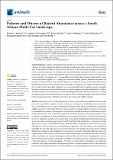Patterns and drivers of rodent abundance across a South African multi-use landscape
Abstract
South Africa’s decentralized approach to conservation entails that wildlife outside formally protected areas inhabit complex multi-use landscapes, where private wildlife business (ecotourism and/or hunting) co-exist in a human-dominated landscape matrix. Under decentralized conservation, wildlife is perceived to benefit from increased amount of available habitat, however it is crucial to understand how distinct management priorities and associated landscape modifications impact noncharismatic taxa, such as small mammals. We conducted extensive ink-tracking-tunnel surveys to estimate heterogeneity in rodent distribution and investigate the effect of different environmental factors on abundance patterns of two size-based rodent groups (small-and medium-sized species), across three adjacent management contexts in NE KwaZulu-Natal, South Africa: a private ecotourism game reserve, mixed farms and traditional communal areas (consisting of small clusters of houses interspersed with grazing areas and seminatural vegetation). Our hypotheses were formulated regarding the (1) area typology, (2) vegetation structure, (3) ungulate pressure and (4) human disturbance. Using a boosted-regression-tree approach, we found considerable differences between rodent groups’ abundance and distribution, and the underlying environmental factors. The mean relative abundance of medium-sized species did not differ across the three management contexts, but small species mean relative abundance was higher in the game reserves, confirming an influence of the area typology on their abundance. Variation in rodent relative abundance was negatively correlated with human disturbance and ungulate presence. Rodent abundance seems to be influenced by environmental gradients that are directly linked to varying management priorities across land uses, meaning that these communities might not benefit uniformly by the increased amount of habitat promoted by the commercial wildlife industry.
Citation
Afonso , B C , Swanepoel , L H , Rosa , B P , Marques , T A , Rosalino , L M , Santos-Reis , M & Curveira-Santos , G 2021 , ' Patterns and drivers of rodent abundance across a South African multi-use landscape ' , Animals , vol. 11 , no. 9 , 2618 . https://doi.org/10.3390/ani11092618
Publication
Animals
Status
Peer reviewed
ISSN
2076-2615Type
Journal article
Description
Funding: This research was funded by FCT/MCTES, through national funds, and the co-funding by the FEDER, within the PT2020 Partnership Agreement and Compete 2020 (cE3c: UIDB/00329/2020), and by the South African National Research Foundation, South Africa (UID 107099&115040). TAM thanks partial support by CEAUL (funded by FCT-Fundação para a Ciência e a Tecnologia, Portugal, through the project UIDB/00006/2020).Collections
Items in the St Andrews Research Repository are protected by copyright, with all rights reserved, unless otherwise indicated.

